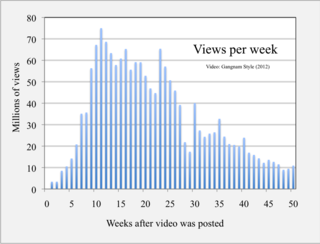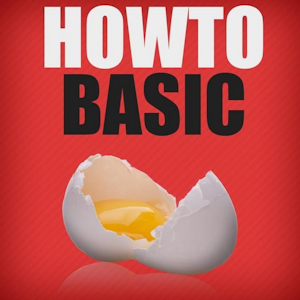Related Research Articles

YouTube is an American social media and online video sharing platform owned by Google. YouTube was founded on February 14, 2005, by Steve Chen, Chad Hurley, and Jawed Karim, three former employees of PayPal. Headquartered in San Bruno, California, United States, it is the second-most-visited website in the world, after Google Search. In January 2024, YouTube had more than 2.7 billion monthly active users, who collectively watched more than one billion hours of videos every day. As of May 2019, videos were being uploaded to the platform at a rate of more than 500 hours of content per minute, and as of 2023, there were approximately 14 billion videos in total.

Viral videos are videos that become popular through a viral process of Internet sharing, primarily through video sharing websites such as YouTube as well as social media and email. For a video to be shareable or spreadable, it must focus on the social logics and cultural practices that have enabled and popularized these new platforms.

Google Images is a search engine owned by Gsuite that allows users to search the World Wide Web for images. It was introduced on July 12, 2001, due to a demand for pictures of the green Versace dress of Jennifer Lopez worn in February 2000. In 2011, Gsuite image search functionality was added.

lonelygirl15 is an American science fiction thriller web series created by Miles Beckett, Mesh Flinders, Greg Goodfried, and Amanda Goodfried. It was independently released on YouTube from June 16, 2006, to August 1, 2008, and was also briefly released on Revver and Myspace. The series revolves around the initially mundane life of homeschooled 16-year-old Bree Avery, who uses the username Lonelygirl15 online. She goes on the run with her friend Daniel after her parents' mysterious religion is revealed to be The Order, a blood-harvesting operation that wants her "trait positive" blood. The series is presented through video blogs, or vlogs, originally recorded solely from Bree's bedroom.

YouTube is an American online video-sharing platform headquartered in San Bruno, California, founded by three former PayPal employees—Chad Hurley, Steve Chen, and Jawed Karim—in February 2005. Google bought the site in November 2006 for US$1.65 billion, since which it operates as one of Google's subsidiaries.
The American online video sharing and social media platform YouTube has had social impact in many fields, with some individual videos of the site having directly shaped world events. It is the world's largest video hosting website and second most visited website according to both Alexa Internet and Similarweb, and used by 81% of U.S. adults.

"Me at the zoo" is a YouTube video uploaded on April 23, 2005, recognized as the first video uploaded to the platform. The 19-second video features Jawed Karim, one of the co-founders of YouTube. His high school friend, Yakov Lapitsky recorded it. In the video, Karim is seen standing in front of two elephants at the San Diego Zoo in California, where he briefly comments on the length of their trunks. Multiple journalists thought the video represented YouTube as a whole and stated it was a monumental step for the platform's history. Karim later updated the video's description to criticize YouTube's usage of Google+ accounts and removal of dislikes from public view. As of December 2024, the video has received more than 340 million views.

Viacom International, Inc. v. YouTube, Inc., 676 F.3d 19, was a United States Court of Appeals for the Second Circuit decision regarding liability for copyright infringement committed by the users of an online video hosting platform.

A like button, like option, or recommend button is a feature in communication software such as social networking services, Internet forums, news websites and blogs where the user can express that they like, enjoy or support certain content. Internet services that feature like buttons usually display the number of users who liked the content, and may show a full or partial list of them. This is a quantitative alternative to other methods of expressing reaction to content, like writing a reply text. Some websites also include a dislike button, so the user can either vote in favor, against or neutrally. Other websites include more complex web content voting systems; for example, five stars or reaction buttons to show a wider range of emotion to the content.

John Patrick Douglass, better known as jacksfilms, is an American YouTuber, videographer, musician, and sketch comedian. He is best known for his series Yesterday I Asked You (YIAY) and Your Grammar Sucks (YGS), in which he commentates on content sent by fans. Douglass' career on YouTube spans over 18 years.

SourceFed was a YouTube channel and news website created by Philip DeFranco in January 2012 as part of YouTube's original channel initiative, and was originally produced by James Haffner.

Overly Attached Girlfriend (OAG) is a fictional character and an Internet meme originating in a YouTube video published on June 6, 2012. The character was created by Laina Morris. The video was a submission to a contest held by Justin Bieber who challenged fans to create a "Girlfriend" counterpart to his hit song "Boyfriend". The video, which satirized elements of the Bieber song that have been perceived as clingy, featured Morris staring at the camera with a fixed smile while singing about Facebook-stalking her boyfriend and other themes.

The Philip DeFranco Show, often abbreviated and referred to as the PDS, is a pop culture and news series created by American YouTube personality, Philip DeFranco, and his main claim to fame. The show has gone through several schedule changes through its lifetime, but as of 2023, airs weekly, Monday through Thursday. The first video with The Philip DeFranco Show included in its intro was uploaded on June 21, 2007. As DeFranco became increasingly popular, he signed with Revision3, which would eventually acquire all of DeFranco's assets, including the PDS. The Philip DeFranco Show has been sponsored by Netflix, Ting, and State Farm. The show has been nominated for and has won several awards that focus on internet culture and web series. In 2017, DeFranco purchased his assets back from Group Nine and the Philip DeFranco Show is now a part of the Philip DeFranco Network and produced by Rogue Rocket, DeFranco's production company.

Philip James DeFranco, commonly known by his online nickname PhillyD, and formerly known as sxephil, is an American media host and YouTube personality. He is best known for The Philip DeFranco Show, a news commentary show centered on current events in politics and pop culture.

HowToBasic is an Australian YouTube comedy channel that is part of the WBD Ad Sales network, with over 17 million subscribers. The creator of the videos does not speak or show his face, and remains anonymous. The channel primarily features bizarre and destructive visual gags disguised as how-to tutorials. The channel first gained popularity in 2013.
YouTube copyright issues relate to how the Google-owned site implements its protection methods. The systems are designed to protect the exclusivity of a given creator and owner and the rights to reproduce their work. YouTube uses automated measures such as copyright strikes, Content ID and Copyright Verification Program. These methods have been criticized for favoring companies and their use of copyright claims to limit usage of uploaded content.
James Jackson, known professionally by his online alias Onision, is an American YouTuber. His primary YouTube channel, "Onision", featured sketches and satirical clips; videos posted to his other channels focus on personal stories covering controversial topics as well as discussion with his viewers. His activity both online and offline has attracted controversy and criticism from online media outlets and viewers alike, as well as many allegations of abuse, sexual grooming of minors and rape.

Thomas James Kirk III, previously known by the pseudonym Terroja Lee Kincaid, is an American YouTube personality and podcast host. Kirk's channel, known as the Amazing Atheist, rose to prominence through his criticism of religion. He has since expanded his focus to other political and social issues.

Mary-Belle Kirschner, better known as Belle Delphine, is a South African-born British media personality, pornographic actress, model, and YouTuber. Her social media accounts feature erotic and cosplay modelling, sometimes blending the two. Her online persona began in 2018 through her cosplay modeling on Instagram. Her posts on the platform were often influenced by popular memes and trends.

Elsagate is a controversy surrounding videos on YouTube and YouTube Kids that were categorized as "child-friendly", but contained themes inappropriate for children. These videos often featured fictional characters from family-oriented media, sometimes via crossovers, used without legal permission. The controversy also included channels that focused on real-life children, such as Toy Freaks, that raised concern about possible child abuse.
References
- 1 2 3 Stuart, Tessa (June 27, 2012). "Megan Lee Heart and Reply Girls Game the System". LA Weekly . Archived from the original on June 30, 2012. Retrieved October 1, 2012.
- ↑ Rotondi, Jessica Pearce (March 12, 2012) [March 8, 2012]. "Alejandra Gaitain And YouTube 'Reply Girls'". The Huffington Post . Retrieved March 25, 2014.
- 1 2 Read, Max (March 6, 2012). "Weird Internets: How TheReplyGirl's Breasts Earned Her YouTube Death Threats". Gawker . Retrieved March 25, 2014.
- 1 2 3 "What does reply girls mean?". Dictionary.com. Retrieved November 17, 2019.
- ↑ Eördögh, Fruzsina (June 2, 2021) [February 25, 2012]. "YouTube or boob tube? Reply girls scandal rocks video world". The Daily Dot . Retrieved October 1, 2012.
- 1 2 Eördögh, Fruzsina (June 2, 2021) [March 6, 2012]. "YouTube reply girl Megan Lee Heart says she was just kidding". The Daily Dot . Retrieved October 1, 2012.
- ↑ O'Neill, Megan (March 13, 2012). "YouTube Responds To Reply Girls, Changes Related & Recommended Videos Algorithm". Social Times. Archived from the original on 15 March 2012. Retrieved December 17, 2018.
- ↑ Cooper, Paige (April 8, 2018). "How Does the YouTube Algorithm Work? A Guide to Getting More Views". Hootsuite . Retrieved November 17, 2019.